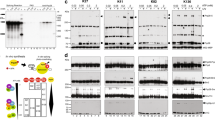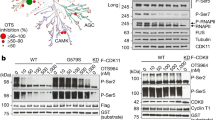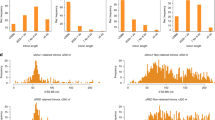Abstract
Kinases and phosphatases participate in precursor messenger RNA (pre-mRNA) splicing regulation, but their precise roles and the identities of their cofactors and substrates remain poorly understood. The human Ser/Thr phosphatase PP2Cγ promotes spliceosome assembly. We show that PP2Cγ's distinctive acidic domain is essential for its activity in splicing and interacts with YB-1, a spliceosome-associated factor. Moreover, PP2Cγ is a phosphoprotein in vivo, and its acidic domain is phosphorylated under splicing conditions in vitro. PP2Cγ phosphorylation enhances its interaction with YB-1 and is reversed by the phosphatase in cis. PP2Cγ knockdown leaves constitutive splicing unaffected but inhibits cell proliferation and affects alternative splicing of CD44, a YB-1 target. This effect on splicing regulation is mediated by PP2Cγ's acidic domain, which is essential to promote inclusion of CD44 exons v4 and v5 in vivo. We propose that PP2Cγ modulates alternative splicing of specific pre-mRNAs coregulated by YB-1.
This is a preview of subscription content, access via your institution
Access options
Subscribe to this journal
Receive 12 print issues and online access
$189.00 per year
only $15.75 per issue
Buy this article
- Purchase on Springer Link
- Instant access to full article PDF
Prices may be subject to local taxes which are calculated during checkout







Similar content being viewed by others
References
Hastings, M.L. & Krainer, A.R. Pre-mRNA splicing in the new millennium. Curr. Opin. Cell Biol. 13, 302–309 (2001).
Kampa, D. et al. Novel RNAs identified from an in-depth analysis of the transcriptome of human chromosomes 21 and 22. Genome Res. 14, 331–342 (2004).
Zhou, Z., Licklider, L.J., Gygi, S.P. & Reed, R. Comprehensive proteomic analysis of the human spliceosome. Nature 419, 182–185 (2002).
Gottschalk, A. et al. A comprehensive biochemical and genetic analysis of the yeast U1 snRNP reveals five novel proteins. RNA 4, 374–393 (1998).
Rappsilber, J., Ryder, U., Lamond, A.I. & Mann, M. Large-scale proteomic analysis of the human spliceosome. Genome Res. 12, 1231–1245 (2002).
Makarov, E.M. et al. Small nuclear ribonucleoprotein remodeling during catalytic activation of the spliceosome. Science 298, 2205–2208 (2002).
Hartmuth, K. et al. Protein composition of human prespliceosomes isolated by a tobramycin affinity-selection method. Proc. Natl. Acad. Sci. USA 99, 16719–16724 (2002).
Jurica, M.S. & Moore, M.J. Pre-mRNA splicing: awash in a sea of proteins. Mol. Cell 12, 5–14 (2003).
Maniatis, T. & Tasic, B. Alternative pre-mRNA splicing and proteome expansion in metazoans. Nature 418, 236–243 (2002).
Reed, R. Mechanisms of fidelity in pre-mRNA splicing. Curr. Opin. Cell Biol. 12, 340–345 (2000).
Tazi, J., Daugeron, M.C., Cathala, G., Brunel, C. & Jeanteur, P. Adenosine phosphorothioates (ATP alpha S and ATP tau S) differentially affect the two steps of mammalian pre-mRNA splicing. J. Biol. Chem. 267, 4322–4326 (1992).
Misteli, T. RNA splicing: what has phosphorylation got to do with it? Curr. Biol. 9, R198–R200 (1999).
Mermoud, J.E., Cohen, P.T. & Lamond, A.I. Regulation of mammalian spliceosome assembly by a protein phosphorylation mechanism. EMBO J. 13, 5679–5688 (1994).
Mermoud, J.E., Cohen, P. & Lamond, A.I. Ser/Thr-specific protein phosphatases are required for both catalytic steps of pre-mRNA splicing. Nucleic Acids Res. 20, 5263–5269 (1992).
Shi, Y., Reddy, B. & Manley, J.L. PP1/PP2A phosphatases are required for the second step of pre-mRNA splicing and target specific snRNP proteins. Mol. Cell 23, 819–829 (2006).
Murray, M.V., Kobayashi, R. & Krainer, A.R. The type 2C Ser/Thr phosphatase PP2Cγ is a pre-mRNA splicing factor. Genes Dev. 13, 87–97 (1999).
Das, A.K., Helps, N.R., Cohen, P.T. & Barford, D. Crystal structure of the protein serine/threonine phosphatase 2C at 2.0 Å resolution. EMBO J. 15, 6798–6809 (1996).
Guthridge, M.A., Bellosta, P., Tavoloni, N. & Basilico, C. FIN13, a novel growth factor-inducible serine-threonine phosphatase which can inhibit cell cycle progression. Mol. Cell. Biol. 17, 5485–5498 (1997).
Tran, H.T., Ulke, A., Morrice, N., Johannes, C.J. & Moorhead, G.B. Proteomic characterization of protein phosphatase complexes of the mammalian nucleus. Mol. Cell. Proteomics 3, 257–265 (2004).
Koizumi, J. et al. The subcellular localization of SF2/ASF is regulated by direct interaction with SR protein kinases (SRPKs). J. Biol. Chem. 274, 11125–11131 (1999).
Labourier, E. et al. Interaction between the N-terminal domain of human DNA topoisomerase I and the arginine-serine domain of its substrate determines phosphorylation of SF2/ASF splicing factor. Nucleic Acids Res. 26, 2955–2962 (1998).
Deckert, J. et al. Protein composition and electron microscopy structure of affinity-purified human spliceosomal B complexes isolated under physiological conditions. Mol. Cell. Biol. 26, 5528–5543 (2006).
Matsumoto, K., Tanaka, K.J. & Tsujimoto, M. An acidic protein, YBAP1, mediates the release of YB-1 from mRNA and relieves the translational repression activity of YB-1. Mol. Cell. Biol. 25, 1779–1792 (2005).
Kohno, K., Izumi, H., Uchiumi, T., Ashizuka, M. & Kuwano, M. The pleiotropic functions of the Y-box-binding protein, YB-1. Bioessays 25, 691–698 (2003).
Ding, J. et al. Crystal structure of the two-RRM domain of hnRNP A1 (UP1) complexed with single-stranded telomeric DNA. Genes Dev. 13, 1102–1115 (1999).
Raftopoulou, M., Etienne-Manneville, S., Self, A., Nicholls, S. & Hall, A. Regulation of cell migration by the C2 domain of the tumor suppressor PTEN. Science 303, 1179–1181 (2004).
Allemand, E. et al. Regulation of heterogenous nuclear ribonucleoprotein A1 transport by phosphorylation in cells stressed by osmotic shock. Proc. Natl. Acad. Sci. USA 102, 3605–3610 (2005).
Tanackovic, G. & Krämer, A. Human splicing factor SF3a, but not SF1, is essential for pre-mRNA splicing in vivo. Mol. Biol. Cell 16, 1366–1377 (2005).
Gunthert, U. CD44: a multitude of isoforms with diverse functions. Curr. Top. Microbiol. Immunol. 184, 47–63 (1993).
Mackay, C.R. et al. Expression and modulation of CD44 variant isoforms in humans. J. Cell Biol. 124, 71–82 (1994).
Stickeler, E. et al. The RNA binding protein YB-1 binds A/C-rich exon enhancers and stimulates splicing of the CD44 alternative exon v4. EMBO J. 20, 3821–3830 (2001).
Pacheco, T.R., Coelho, M.B., Desterro, J.M., Mollet, I. & Carmo-Fonseca, M. In vivo requirement of the small subunit of U2AF for recognition of a weak 3′ splice site. Mol. Cell. Biol. 26, 8183–8190 (2006).
Käufer, N.F. & Potashkin, J. Analysis of the splicing machinery in fission yeast: a comparison with budding yeast and mammals. Nucleic Acids Res. 28, 3003–3010 (2000).
Kimura, H. et al. A novel histone exchange factor, protein phosphatase 2Cγ, mediates the exchange and dephosphorylation of H2A–H2B. J. Cell Biol. 175, 389–400 (2006).
Batsché, E., Yaniv, M. & Muchardt, C. The human SWI/SNF subunit Brm is a regulator of alternative splicing. Nat. Struct. Mol. Biol. 13, 22–29 (2006).
Matsumoto, K. & Wolffe, A.P. Gene regulation by Y-box proteins: coupling control of transcription and translation. Trends Cell Biol. 8, 318–323 (1998).
Soop, T. et al. A p50-like Y-box protein with a putative translational role becomes associated with pre-mRNA concomitant with transcription. J. Cell Sci. 116, 1493–1503 (2003).
Jurica, M.S., Licklider, L.J., Gygi, S.R., Grigorieff, N. & Moore, M.J. Purification and characterization of native spliceosomes suitable for three-dimensional structural analysis. RNA 8, 426–439 (2002).
Ballif, B.A., Villen, J., Beausoleil, S.A., Schwartz, D. & Gygi, S.P. Phosphoproteomic analysis of the developing mouse brain. Mol. Cell. Proteomics 3, 1093–1101 (2004).
Beausoleil, S.A. et al. Large-scale characterization of HeLa cell nuclear phosphoproteins. Proc. Natl. Acad. Sci. USA 101, 12130–12135 (2004).
Wang, X. et al. Phosphorylation of splicing factor SF1 on Ser20 by cGMP-dependent protein kinase regulates spliceosome assembly. EMBO J. 18, 4549–4559 (1999).
Matter, N., Herrlich, P. & König, H. Signal-dependent regulation of splicing via phosphorylation of Sam68. Nature 420, 691–695 (2002).
Zhang, W. & Chait, B.T. ProFound: an expert system for protein identification using mass spectrometric peptide mapping information. Anal. Chem. 72, 2482–2489 (2000).
Mayeda, A. & Krainer, A.R. Preparation of HeLa cell nuclear and cytosolic S100 extracts for in vitro splicing. Methods Mol. Biol. 118, 309–314 (1999).
Kohtz, J.D. et al. Protein-protein interactions and 5′-splice-site recognition in mammalian mRNA precursors. Nature 368, 119–124 (1994).
Mayeda, A. & Krainer, A.R. Regulation of alternative pre-mRNA splicing by hnRNP A1 and splicing factor SF2. Cell 68, 365–375 (1992).
Cartegni, L., Hastings, M.L., Calarco, J.A., de Stanchina, E. & Krainer, A.R. Determinants of exon 7 splicing in the spinal muscular atrophy genes, SMN1 and SMN2. Am. J. Hum. Genet. 78, 63–77 (2006).
Julien, E. & Herr, W. Proteolytic processing is necessary to separate and ensure proper cell growth and cytokinesis functions of HCF-1. EMBO J. 22, 2360–2369 (2003).
Huang, Y. & Carmichael, G.G. A suboptimal 5′ splice site is a cis-acting determinant of nuclear export of polyomavirus late mRNAs. Mol. Cell. Biol. 16, 6046–6054 (1996).
Habets, W.J., Hoet, M.H., De Jong, B.A., Van der, K.A. & Van Venrooij, W.J. Mapping of B cell epitopes on small nuclear ribonucleoproteins that react with human autoantibodies as well as with experimentally-induced mouse monoclonal antibodies. J. Immunol. 143, 2560–2566 (1989).
Acknowledgements
We thank S. Berget (Baylor College of Medicine) for the CD44 v4-v5 minigene, T. Cooper (Baylor College of Medicine) for YB-1 plasmids, J. Tazi (Institut de Génétique Moléculaire de Montpellier) for plasmid pET14b-hSC35, D. Barford (Chester Beatty Laboratories) for recombinant PP2Cα protein, G. Dreyfuss (University of Pennsylvania School of Medicine) for the hnRNP A1–specific 4B10 antibody, S. Dokudovskaya and C. Muchardt for useful comments on the manuscript, and E. Batsché for helpful advice on the qPCR experiments. This work was supported by US National Institutes of Health grant GM42699 to A.R.K.
Author information
Authors and Affiliations
Corresponding author
Ethics declarations
Competing interests
The authors declare no competing financial interests.
Supplementary information
Supplementary Fig. 1
Alignment of PP2Cγ AD from several species. (PDF 159 kb)
Supplementary Fig. 2
Interaction of PP2Cγ and YB-1 does not require RNA. (PDF 184 kb)
Supplementary Fig. 3
Phosphorylation of the AD of PP2Cγ. (PDF 343 kb)
Supplementary Fig. 4
Stability and dephosphorylation of PP2Cγ. (PDF 435 kb)
Supplementary Fig. 5
Phosphorylation state of inactive phosphatase affects YB-1 interaction. (PDF 191 kb)
Supplementary Fig. 6
Depletion of PP2Cγ affects cell growth. (PDF 164 kb)
Supplementary Fig. 7
Knockdown of PP2Cγ by siRNA treatment. (PDF 1287 kb)
Supplementary Fig. 8
PP2Cγ knockdown does not affect β-globin splicing. (PDF 453 kb)
Supplementary Fig. 9
PP2γ knockdown does not affect E1A splicing. (PDF 341 kb)
Supplementary Fig. 10
PP2Cγ knockdown attenuates the effect of YB-1 on CD44 alternative splicing. (PDF 1515 kb)
Rights and permissions
About this article
Cite this article
Allemand, E., Hastings, M., Murray, M. et al. Alternative splicing regulation by interaction of phosphatase PP2Cγ with nucleic acid–binding protein YB-1. Nat Struct Mol Biol 14, 630–638 (2007). https://doi.org/10.1038/nsmb1257
Received:
Accepted:
Published:
Issue Date:
DOI: https://doi.org/10.1038/nsmb1257
This article is cited by
-
PPM1G promotes the progression of hepatocellular carcinoma via phosphorylation regulation of alternative splicing protein SRSF3
Cell Death & Disease (2021)
-
The catalytic role of the M2 metal ion in PP2Cα
Scientific Reports (2015)
-
A complex network of factors with overlapping affinities represses splicing through intronic elements
Nature Structural & Molecular Biology (2013)
-
Interactome analysis reveals versatile functions of Arabidopsis COLD SHOCK DOMAIN PROTEIN 3 in RNA processing within the nucleus and cytoplasm
Cell Stress and Chaperones (2013)
-
An intranucleolar body associated with rDNA
Chromosoma (2011)



